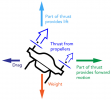Is there any difference in sport mode vs normal mode when it comes to how long you can fly?
When i been flying far away and the 20% warning starts beeping, i sometimes put it in sport mode and fly as fast as i can to home.
But is this really more efficient than flying slower in normal mode?
I have not made any testing on this, but it feels like the sportmode is better to use in headwind when the normal mode can be extremly slow.
One time i was 1.5 km away and it started to blow very hard so the drone did like 1,5m/s, and when i put it in sportmode it was over 4m/s.
Was thinking the sport mode would drain the battery much faster but i dont think thats correct.
When i been flying far away and the 20% warning starts beeping, i sometimes put it in sport mode and fly as fast as i can to home.
But is this really more efficient than flying slower in normal mode?
I have not made any testing on this, but it feels like the sportmode is better to use in headwind when the normal mode can be extremly slow.
One time i was 1.5 km away and it started to blow very hard so the drone did like 1,5m/s, and when i put it in sportmode it was over 4m/s.
Was thinking the sport mode would drain the battery much faster but i dont think thats correct.











